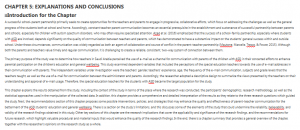CHAPTER 5: EXPLANATIONS AND CONCLUSIONS

Introduction for the Chapter
A successful school-parent partnership primarily seeks to create opportunities for the teachers and parents to engage in progressive, collaborative efforts, which focus on addressing the challenges as well as the general progress of the students both at school and home. Accordingly, constant teacher-parent communication becomes an essential prerequisite in the establishment and sustenance of successful partnership between parents and schools, especially for children with autism spectrum disorders, who may often require specialized attention. Azad et al. (2016) emphasized that the success of a school-family partnership, especially where students with ASD are involved, depends significantly on the quality of communication between teachers and parents, which has demonstrated to have a substantive impact on the students’ general success within and outside school. Under these circumstances, communication was widely regarded as both an agent of collaboration and source of conflict in the parent-teacher partnership (Mautone, Marcelle, Tresco, & Power, 2015). Although both the parents and teachers value timely and regular communication, it is challenging to create a reliable, consistent, two-way system of connection between them.
The primary purpose of the study was to determine how teachers in Saudi Arabia perceived the use of e-mail as a channel for communication with parents of the children with ASD, in their concerted efforts to enhance parental participation on the children’s education and general wellbeing. This study examined dependent variables that included the perceptions of the special education teachers towards the use of e-mail addresses in their communication with parents. The independent variables under investigation were the teachers’ gender, teachers’ experience, age, the frequency of the e-mail communication, subjects and grade levels that the teachers taught, as well as the use of e-mail for communication between the administrator and parents. Accordingly, the researcher adopted a descriptive design to summarize the views presented by the teachers on their understanding and approval of e-mail usage. Therefore, the special education teachers for the students with ASD became the target population for the study.
This chapter explains the results obtained from the study, including the context of the study in terms of the place where the research was conducted, the participants’ demographics, research methodology, as well as the statistical approaches used in the manipulation of the collected data. In addition, this chapter provides a comprehensive and detailed interpretation of the results as they relate to the three research questions which guided the study. Next, the recommendations section of this chapter proposes some possible interventions, policies, and strategies that may enhance the quality and effectiveness of parent-teacher communication for the betterment of the ASD students’ education and general wellbeing. There is a section on the study’s limitations, and this discusses some of the elements of the study that could undermine the reliability, believability, and validity of the research findings obtained in this study. Other key sections of this chapter are the research implications that cover the applicability and significance of the research findings, and the recommendations for future research, which highlight valuable procedural and material inputs that would enhance the quality of the research findings. In the end, there is a chapter summary that provides a general overview of the chapter, together with the researcher’s opinions on the research study as a whole.
Context of the Study
The target population of the study was elementary special education educations school teachers in Saudi Arabia’s Eastern region, which is the country’s largest province. Therefore, for inclusion in the research study, the target respondents had to be special education teachers who dealt with children with ASD and came from the Eastern region of Saudi Arabia. In the end, the sample consisted of 83 teachers, 57 of who were male and 25 who were female. The most popular age group for the sampled population was between 24 and 39 years of age, while the least popular was those teachers above the age of 59 years. Given the nature of data required based on the research questions, a mixed research approach was favored for this research, and it included a descriptive survey using a Likert scale and semi-structured interviews with the participating teachers.
The examination of the research questions began in the first phase, where the quantitative data were gathered from the participants using the 26 questions listed in the survey. After the research data were downloaded into an Excel file from Qualtrics, it was subsequently cleaned by excluding participants who failed to provide their consent. The statistical package for social science (SPSS) was the preferred format for the coding of the participants’ responses (Azad & Mandell, 2016). Accordingly, the coded answers formed the core of the analysis phase, where they were used to respond to the research questions. In this case, the data collected were analyzed to explore the perspectives that the individual special education school teachers had towards the identified variables, namely the use of e-mail messaging as a tool of communication between the teachers and parents. In particular, the surveys were fed into the SPSS for eventual analysis using the descriptive statistics, variance test analysis, as well as the t-test, which ultimately revealed how the teachers perceived the variables under investigation.
After the successful execution of the survey process and the analysis of the data collected, the researcher conducted a series of eight qualitative interviews, where respondents provided their views, opinions, and approval or disapproval of the e-mail communication platform as part of the parent-teacher collaboration. In the end, the findings of the interviews were organized in correspondence with the respective research questions, and this provided the ease of readability and contextual interpretation of the responses provided by the participants.
For this research, three questions were formulated, and used to obtain the views and opinions of the teachers in a more comprehensive, open, and clear way. The questions were: